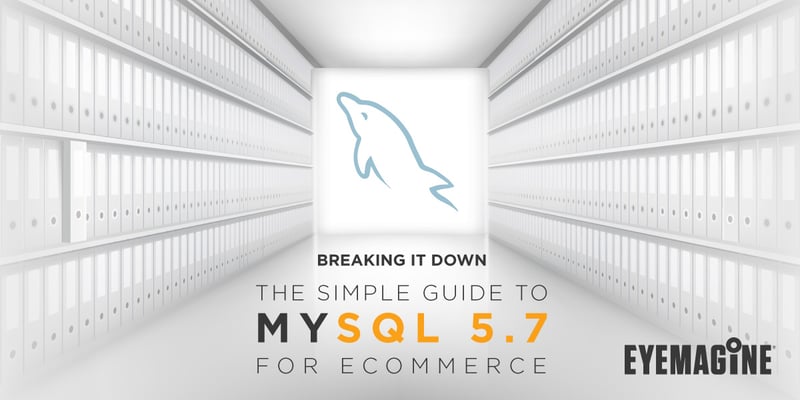What is MySQL and SQL?
MySQL is an open source relational database management system (RDBMS). MySQL organizes data, making it easy to access and analyze.
Think of a database as a big warehouse. For an eCommerce site, this warehouse is usually filled to the brim with things like product data, inventory information, details for each page of the site, etc. MySQL declutters and organizes this warehouse so that both the site owner and the site visitors can access the information that they are looking for quickly and efficiently.
In case you heard the word but not sure what it means, we will explain MySQL. MySQL accesses and organizes all of this information into tables using the SQL, or “Structured Query Language.” This is the most common standardized language used to access, manage, or add content to a database. It works as an interpreter of computer languages, allowing different software applications to talk to one another. For example, if you have 30 different warehouses — with some organized in Russian, some in Spanish, and some in Japanese — MySQL will still be able to understand and organize all of the information.
The beauty of SQL and the MySQL server is that it can function across different back-ends, APIs and networks, without losing speed, connectivity or security. For eCommerce retailers, this means that they can scale their online store and increase its features and functionality without compromising page load speed or reliability.
The Standard: MySQL 5.5
Most Magento eCommerce stores still run on MySQL 5.5, an old and outdated version of MySQL. Merchants may be hesitant to upgrade because version 5.5 works well enough and may be optimized for the current server environment. An upgrade may be labor intensive and time consuming.
MySQL 5.5 database server is outdated and too slow for new applications, like Magento 2. eCommerce merchants should upgrade and MySQL 5.7 should be the new standard for all open-source eCommerce website development.
MySQL 5.7: Faster, More Robust, Better Performance
In various tests, we found that MySQL 5.7 vastly outperforms both MySQL 5.6 and MySQL 5.5. An upgrade to 5.7 would be a profitable move across the board. According to an Oracle White Page MySQL Performance Benchmark test, "MySQL 5.7 delivers 1,600,000 Queries/Second in the Point Select query benchmark, 3x faster than MySQL 5.6," meaning that MySQL 5.7 can handle more traffic and simultaneous users. For an eCommerce retailer, this is huge. When servers crash or pages fail to load, revenue decreases. Especially in today’s day and age, people expect speed and reliability; MySQL 5.7 delivers both.

Important New Feature: Native JSON Support
Many of these improvements have to do with the Native JSON Support that MYSQL 5.7 offers. JSON is a very important part of most communications between different applications. It helps simplify data and send it across platforms or between applications from the server to the client or web browser application. In MySQL 5.7, a new data type for storing JSON data in MySQL tables has been added. Having this native data type for JSON provides major benefits, including:
- Document Validation: Only valid JSON documents can be stored in a JSON column, so you get automatic validation of your data.
- Efficient Access: When you store a JSON document in a JSON column, it is not stored as a plain text value. Instead, it is stored in an optimized binary format that allows for quicker access to object members and array elements.
- Performance: Improve your query performance by creating indexes on values within the JSON columns. This can be achieved with “functional indexes” on virtual columns.
- Convenience: The additional inline syntax for JSON columns makes it very natural to integrate Document queries within your SQL. For example (features.feature is a JSON column):
SEE ALSO: 6 User Experience (UX) Tips That Will Unlock eCommerce Success
MySQL 5.7: A Stronger Tool
New tools and features make it possible to blend relational and document paradigms using the MySQL 5.7 database. Normally, MySQL is strictly a relational database. This means that, in order for documents to be stored, developers must know and define all possible attributes of any product ahead of time. As a result of this limitation, developers would usually have to work with two separate tools: a MySQL relational database and a NoSQL document store database. Using the warehouse analogy, the MySQL database would organize the sections and tables in the warehouse, while the NoSQL would read and understand the details of each item in those sections.
MySQL 5.7 is the first version of MySQL that can be configured as a relational database and as a document store. For the first time ever, developers can use one single tool with storing and retrieving JSON data. This new feature could prove very useful, reducing the cost of development and providing flexibility.
Overall, MySQL 5.7 is stronger, more robust and more efficient than both MySQL 5.5 and MySQL 5.6. eCommerce retailers need to make the update if they want to increase the performance of their online store, especially as they switch to the Magento 2 platform. Like the PHP 7 update, this updated version will increase page load speed, functionality, and overall revenue for eCommerce brands.



